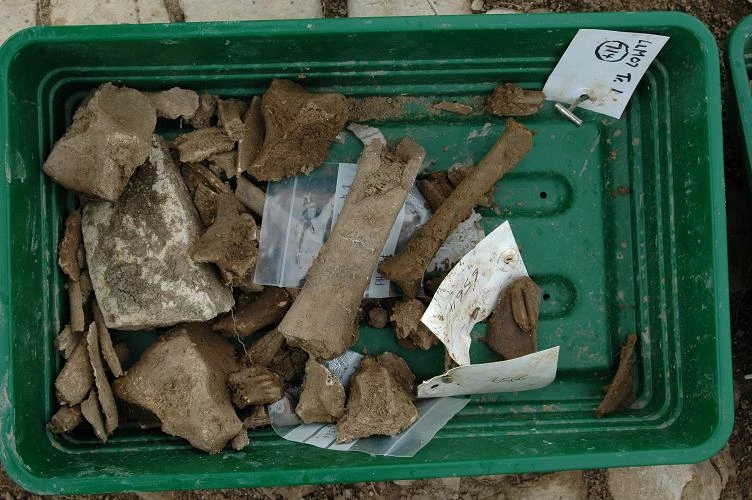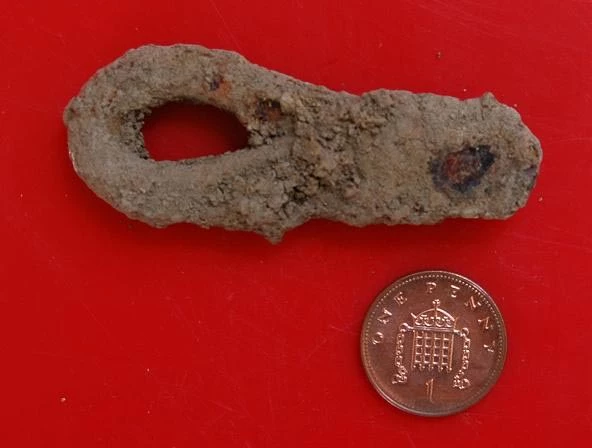Thursday 5th July
, 5 July 2007
Contributed by CAROLINE and the pupils of ARCHDEACON JOHN LEWIS PRIMARY SCHOOL
The children have been working on a School Performance entitled “Rainbow people.” Today they performed to the archaeologists while they were on tea break. It is a story which is both appropriate for today and for societies in the past. The story taught us that race and religion is irrelevant that people can still be friends despite these small differences. The story is appropriate in the context of Llanmaes, with evidence of both Roman and Iron Age occupation. The inhabitants of Llanmaes would have been a mixture of Romans and natives and potentially integrated, hopefully relatively peacefully.
The piece was performed twice, the first was narrated by the teacher and several of the school children.
The children chant while banging buckets with wooden spoons:
‘Green people are happy, blue people are sad
Green people are good, blue people are bad’
(and vice versa for the blue people)
To further strengthen the story’s connection with the excavation, the children played on buckets- a vital accessory for an archaeologist!
The green people and the blue people disliked each other and were ignorant of each others ways and believed themselves to be better than others. However, when a younger member of the green group was hurt and helped by a young blue person, and the favour was later returned, the two young people realised the idiocy of disliking those from the other group. The younger generation taught the rest of society that they are wrong and that all people are equal and worthy of friendship and co-operation.
The children then performed the story through the medium of dance accompanied by a musical score composed by a Welsh musician.
The children were asked some questions about their performance and the archaeology at Llanmaes.
"What was the performance trying to teach us and how is it relevant to the Llanmaes excavation?"
Emma
“The play teaches us that friendship and working together is important. The performance of the Rainbow People helps to show that.”
Hywel
“The dig is like the play because the archaeologist work together, teamwork is important and they are unselfish like the people did at the end of the story.”
Olivia
“The play is like the dig because the archaeologists found places in their heart that made them want to work together as a team and not to be an outsider.”
William2
“The archaeologists like the Rainbow people came together as a group and formed bonds of friendship.”
Ashton
“The Rainbow People didn’t like each other nor did the Romans and the Celts until they joined together and worked together. The Romans came to the Celts land and had to get along with one another.”
William2
“The Celts and the Romans at first fought and bullied each other just and warred with one another, just as the Green and Blue people did.”
"What message would you give to the Celts and the Romans?"
James
“Don’t be enemies.”
William2
“Don’t be nasty.”
Hywel
“It doesn’t matter if you are a different colour or follow a different religion, we are all one and are part of the same human family.”
James
“No one is better than anyone else.”
Ashton
“No one is really bad.”
William2
“Wealth is unimportant, Even if your people’s possessions seem nicer than other peoples’ it doesn’t make you better than them. The Romans had better weapons and pottery but are not better than the Celts.”
"What did you think of the excavation? What did you like most about visiting an archaeological dig?"
Olivia
“I was excited, especially because they find lots of things.”
William2
“Amazed.”
Hywel
“I was frightened at the beginning, it’s a strange new place. But then interested after having looked around and learning about what is really happening.”
Fabbio
“It’s interesting to see what they did years ago.”
Emma
“I liked the dogs”
"Would you like to be an archaeologist? Why?"
William2
“I would like to be an archaeologist because I like the Romans”
Hywel
“I’d like to be an archaeologist so that I could find out what happened before Jesus Christ.”
William1
“In one way yes I’d like to be an archaeologist because you get to find out what happened before Jesus Christ, in another way no I would not like to be an archaeologist because you can hurt yourself.” (even though he plays rugby)
Josh
“You can hurt yourself if you’re an archaeologist because sharp objects are dangerous”
James
“I don’t want to be an archaeologist because it takes too long to dig and is very hard work”
Grace
“To be an archaeologist you need lots of patience”
Hywel
“I’d like to be an archaeologist to be famous and in a magazine.”
William2
“I’d like to find out what the Romans had.”
Olivia
“The farmer is also famous because he has an archaeological dig on his farm.”
James
“I’d like to be an archaeologist because it is really exciting”


